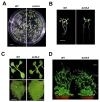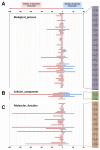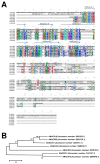The Direct Involvement of Dark-Induced Tic55 Protein in Chlorophyll Catabolism and Its Indirect Role in the MYB108-NAC Signaling Pathway during Leaf Senescence in Arabidopsis thaliana
- PMID: 29937503
- PMCID: PMC6073118
- DOI: 10.3390/ijms19071854
The Direct Involvement of Dark-Induced Tic55 Protein in Chlorophyll Catabolism and Its Indirect Role in the MYB108-NAC Signaling Pathway during Leaf Senescence in Arabidopsis thaliana
Abstract
The chloroplast relies on proteins encoded in the nucleus, synthesized in the cytosol and subsequently transported into chloroplast through the protein complexes Toc and Tic (Translocon at the outer/inner membrane of chloroplasts). A Tic complex member, Tic55, contains a redox-related motif essential for protein import into chloroplasts in peas. However, Tic55 is not crucial for protein import in Arabidopsis. Here, a tic55-II-knockout mutant of Arabidopsis thaliana was characterized for Tic55 localization, its relationship with other translocon proteins, and its association with plant leaf senescence when compared to the wild type. Individually darkened leaves (IDLs) obtained through dark-induced leaf senescence were used to demonstrate chlorophyll breakdown and its relationship with plant senescence in the tic55-II-knockout mutant. The IDLs of the tic55-II-knockout mutant contained higher chlorophyll concentrations than those of the wild type. Our microarray analysis of IDLs during leaf senescence identified seven senescence-associated genes (SAGs) that were downregulated in the tic55-II-knockout mutant: ASP3, APG7, DIN2, DIN11, SAG12, SAG13, and YLS9. Real-time quantitative PCR confirmed the reliability of microarray analysis by showing the same expression patterns with those of the microarray data. Thus, Tic55 functions in dark-induced aging in A. thaliana by indirectly regulating downstream SAGs expression. In addition, the expression of four NAC genes, including ANAC003, ANAC010, ANAC042, and ANAC075 of IDL treated tic55-II-knockout mutant appeared to be downregulated. Yeast one hybrid assay revealed that only ANAC003 promoter region can be bound by MYB108, suggesting that a MYB-NAC regulatory network is involved in dark-stressed senescence.
Keywords: ANAC proteins; MYB108; Tic55 proteins of chloroplasts; dark-induced leaf senescence.
Conflict of interest statement
The authors declare no conflict of interest.
Figures









Similar articles
-
Chloroplast Protein Tic55 Involved in Dark-Induced Senescence through AtbHLH/AtWRKY-ANAC003 Controlling Pathway of Arabidopsis thaliana.Genes (Basel). 2022 Feb 6;13(2):308. doi: 10.3390/genes13020308. Genes (Basel). 2022. PMID: 35205352 Free PMC article.
-
Arabidopsis NAC016 promotes chlorophyll breakdown by directly upregulating STAYGREEN1 transcription.Plant Cell Rep. 2016 Jan;35(1):155-66. doi: 10.1007/s00299-015-1876-8. Epub 2015 Oct 6. Plant Cell Rep. 2016. PMID: 26441053
-
The role of ANAC072 in the regulation of chlorophyll degradation during age- and dark-induced leaf senescence.Plant Cell Rep. 2016 Aug;35(8):1729-41. doi: 10.1007/s00299-016-1991-1. Epub 2016 May 6. Plant Cell Rep. 2016. PMID: 27154758
-
Protein import into chloroplasts: the Tic complex and its regulation.Biochim Biophys Acta. 2010 Jun;1803(6):740-7. doi: 10.1016/j.bbamcr.2010.01.015. Epub 2010 Jan 25. Biochim Biophys Acta. 2010. PMID: 20100520 Review.
-
Genetic redundancy of senescence-associated transcription factors in Arabidopsis.J Exp Bot. 2018 Feb 12;69(4):811-823. doi: 10.1093/jxb/erx345. J Exp Bot. 2018. PMID: 29309664 Review.
Cited by
-
Side-chain modifications of phyllobilins may not be essential for chlorophyll degradation in Arabidopsis.Plant Direct. 2022 Aug 24;6(8):e441. doi: 10.1002/pld3.441. eCollection 2022 Aug. Plant Direct. 2022. PMID: 36035897 Free PMC article.
-
Deciphering the roles of tobacco MYB transcription factors in environmental stress tolerance.Front Plant Sci. 2022 Oct 24;13:998606. doi: 10.3389/fpls.2022.998606. eCollection 2022. Front Plant Sci. 2022. PMID: 36352868 Free PMC article.
-
RhMYB108, an R2R3-MYB transcription factor, is involved in ethylene- and JA-induced petal senescence in rose plants.Hortic Res. 2019 Dec 1;6:131. doi: 10.1038/s41438-019-0221-8. eCollection 2019. Hortic Res. 2019. PMID: 31814984 Free PMC article.
-
Understanding protein import in diverse non-green plastids.Front Genet. 2023 Mar 16;14:969931. doi: 10.3389/fgene.2023.969931. eCollection 2023. Front Genet. 2023. PMID: 37007964 Free PMC article. Review.
-
Genome-wide analyses of the NAC transcription factor gene family in Acer palmatum provide valuable insights into the natural process of leaf senescence.PeerJ. 2025 Jan 13;13:e18817. doi: 10.7717/peerj.18817. eCollection 2025. PeerJ. 2025. PMID: 39822972 Free PMC article.
References
MeSH terms
Substances
LinkOut - more resources
Full Text Sources
Other Literature Sources
Molecular Biology Databases

